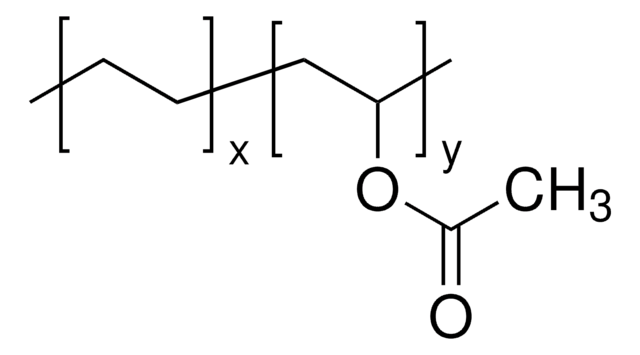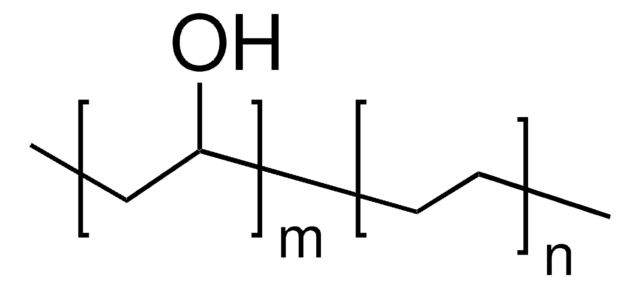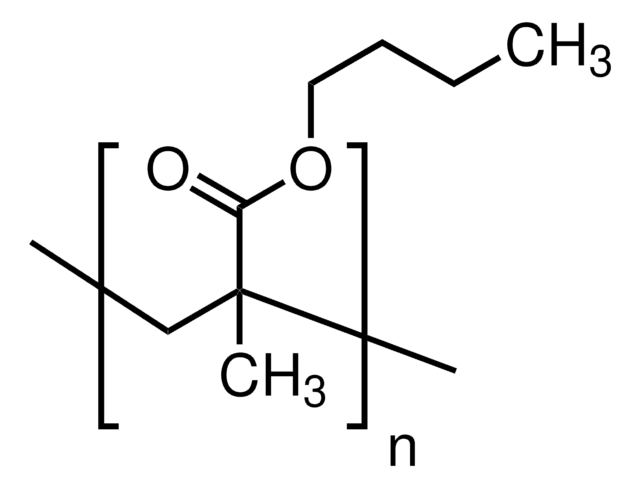340502
Poly(ethylene-co-vinyl acetate)
vinyl acetate 40 wt. %, melt index (41-63 dg/min (190°C/2.16kg)), contains 190-910 ppm inhibitor
Sinónimos:
PEVA
About This Item
Productos recomendados
form
beads
autoignition temp.
500 °F
melt index
(41-63 dg/min (190°C/2.16kg))
contains
190-910 ppm inhibitor
composition
vinyl acetate, 40 wt. %
hardness
40 (Shore A-2, ASTM D 2240)
transition temp
Tg −40-−30 °C
Tm 110-120 °C
solubility
toluene, THF, and MEK: soluble
SMILES string
C=C.CC(=O)OC=C
InChI
1S/C4H6O2.C2H4/c1-2-3-4(5)6;1-2/h2H,1,3H2,(H,5,6);1-2H2
InChI key
DQXBYHZEEUGOBF-UHFFFAOYSA-N
¿Está buscando productos similares? Visita Guía de comparación de productos
Categorías relacionadas
General description
Application
- Correlation between Cohesive Energy Density, Fractional Free Volume, and Gas Transport Properties: This study explores the properties of EVA materials that affect their gas permeability, important for applications like packaging and barrier materials (Kubica & Wolinska-Grabczyk, 2015).
- The Thermal and Mechanical Properties of EVA and its Crosslinked Analogues: This research investigates how crosslinking affects the thermal and mechanical properties of EVA, which could interest material scientists working with polymers (Wang & Deng, 2019).
- Investigation of morphological, rheological, and mechanical properties of cyclic olefin copolymer/EVA blend films: This study focuses on the blend properties of EVA with other polymers, providing insights useful in academia and material science (Durmus et al., 2018).
- Fabrication, characterization, and properties of EVA/magnetite nanocomposites: Relevant to material scientists, this research discusses the incorporation of magnetite nanoparticles into EVA for enhanced properties (Ramesan, 2014).
Storage Class
11 - Combustible Solids
wgk_germany
nwg
flash_point_f
Not applicable
flash_point_c
Not applicable
ppe
Eyeshields, Gloves, type N95 (US)
Elija entre una de las versiones más recientes:
¿Ya tiene este producto?
Encuentre la documentación para los productos que ha comprado recientemente en la Biblioteca de documentos.
Nuestro equipo de científicos tiene experiencia en todas las áreas de investigación: Ciencias de la vida, Ciencia de los materiales, Síntesis química, Cromatografía, Analítica y muchas otras.
Póngase en contacto con el Servicio técnico


![[1R-(2-endo,3-exo)]-3-Hydroxy-4,7,7-trimethylbicyclo[2.2.1]heptane-2-acetic acid 99%](/deepweb/assets/sigmaaldrich/product/structures/302/015/ab0ad101-2636-4430-bd07-e61d744f6817/640/ab0ad101-2636-4430-bd07-e61d744f6817.png)



